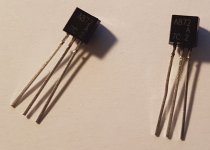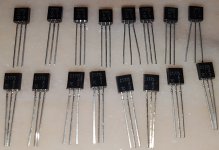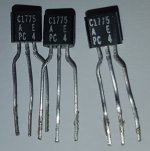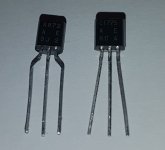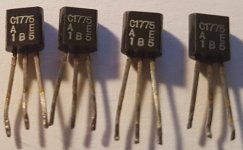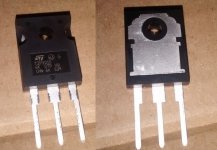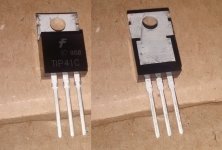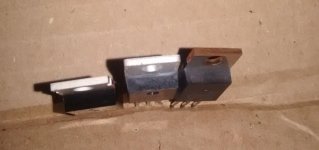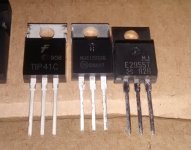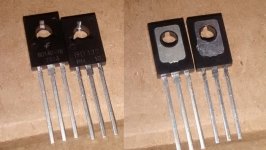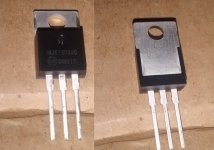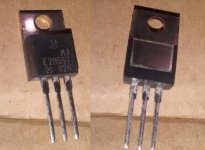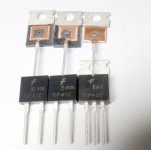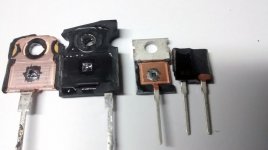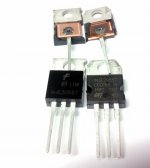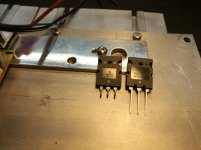The 2N3055 was designed as a power supply pass transistor. It is pretty crappy for output transistors. Just because they did it cheap and nasty back then doesn't mean you should. Honestly, try to get some good output transistors and use them. If you can get the new On-Semi parts (who now make 2S and KS series parts), you're way ahead of the game.
Any of the MJW parts are great - as most of them are from On-Semi. I can't even see any reason even think of the 2N3055. Forget they ever existed, they weren't very good.
Doesn't an amplifier that has been designed for 2N3005's need a modified compensation, if these power devices were replaced by »better« - and faster - ones?
Best regards!
Not necessarily. If measures were taken in the design to force it to work with ridiculously slow transistors (say 200khz germanium or early hometaxials) it would need adjustment, mostly for local stability. If it is something with a relatively low to moderate loop gain, employing the 2 MHz modern ones it will likely work with faster outputs with no trouble. For the most part, using faster outputs results in more overall loop stability margin.
Hi guys
Unfortunately here in Brazil isn't easy find the newest devices, even the olders like MJL.. Much fake transistors, even the BC54x family..
I realy thinked in MJ4502 and MJ802 to replace some amplifiers, and MJ15003 and MJ15004.. is Relatively easy find some originals.
I was soo sad when i saw that the Shipping value from Mouser and Farnell.. $35.00..
One dollar worth around R$ 3.30 (Real, our money). Soo the shipping will be R$ 115.00, for comparation, the MJ4502 original was R$ 9.80. No condition for import parts
And here in Brazil we have a import tax of 60%...
Unfortunately here in Brazil isn't easy find the newest devices, even the olders like MJL.. Much fake transistors, even the BC54x family..
I realy thinked in MJ4502 and MJ802 to replace some amplifiers, and MJ15003 and MJ15004.. is Relatively easy find some originals.
I was soo sad when i saw that the Shipping value from Mouser and Farnell.. $35.00..
One dollar worth around R$ 3.30 (Real, our money). Soo the shipping will be R$ 115.00, for comparation, the MJ4502 original was R$ 9.80. No condition for import parts
And here in Brazil we have a import tax of 60%...
Hi guys
Unfortunately here in Brazil isn't easy find the newest devices, even the olders like MJL.. Much fake transistors, even the BC54x family..
I realy thinked in MJ4502 and MJ802 to replace some amplifiers, and MJ15003 and MJ15004.. is Relatively easy find some originals.
I was soo sad when i saw that the Shipping value from Mouser and Farnell.. $35.00..
One dollar worth around R$ 3.30 (Real, our money). Soo the shipping will be R$ 115.00, for comparation, the MJ4502 original was R$ 9.80. No condition for import parts
And here in Brazil we have a import tax of 60%...
Hello Rafael
If your components total price is 50 $ or more then Mouser shipping is free
Hello Rafael
If your components total price is 50 $ or more then Mouser shipping is free
Hummm, good to know..
Thank's
Brazil has an enormous population, surely there are manufacturers producing parts to meet the demands of that population.Hi guys
Unfortunately here in Brazil isn't easy find the newest devices, even the olders like MJL.. Much fake transistors, even the BC54x family..
I realy thinked in MJ4502 and MJ802 to replace some amplifiers, and MJ15003 and MJ15004.. is Relatively easy find some originals.
I was soo sad when i saw that the Shipping value from Mouser and Farnell.. $35.00..
One dollar worth around R$ 3.30 (Real, our money). Soo the shipping will be R$ 115.00, for comparation, the MJ4502 original was R$ 9.80. No condition for import parts
And here in Brazil we have a import tax of 60%...
I was a little surprised when I visited Turkey recently. I should not have been since it's population is much higher than the UK's and they have set up an infrastructure to satisfy those internal demands.
To my knowledge, Brazil doesn't manufacture power transistors, which means they have to be imported or smuggled. Hell, the US doesn't manufacture silicon power transistors either - the closest is ON's plant in Mexico. Legal importing may not be cost effective - where the freight and taxes/duty far exceed the cost of the parts. Paying $100 to build a small amp that has $8 worth of parts in it is stupid. So for people on a budget in some areas of the world relying on dwindling old stock, questionable sources, or parting out old equipment may be the only options. My favorite back in the ramen noodle days was parting out old equipment. Where you typically pick up lots of old 2N3055s. And back in those days Mouser and Digikey didn't carry full lines, and Newark was just getting off the ground. It was a challenge to get audio transistors even if you did have the money It is a luxury that most of us in the US can just go on line and order from Mouser and have stuff delivered in a few days without overpaying or having our shipments intercepted. It wasn't always that way, and in some places it may never be.
.... Hell, the US doesn't manufacture silicon power transistors either - the closest is ON's plant in Mexico.
Microsemi has power transistor fabs in California, Massachusetts and Oregon ....to meet US/ONI "made in US" requirements. Some may be RF Power/SGS fab acquires, but still in the US.......
I've been on the purchasing side of things before with them. Birth-to-ship certs and house numbering for exclusion - they do it well.
You mean the home of the $55 2N3715? And I'm pretty sure you can get a current production MT200 LAPT delivered anywhere in the world for that. Then again, maybe not depending on the level of corruption in place.
You know what I mean. Real audio transistors, fair price. Is it too much to ask?
You know what I mean. Real audio transistors, fair price. Is it too much to ask?
You mean the home of the $55 2N3715? And I'm pretty sure you can get a current production MT200 LAPT delivered anywhere in the world for that. Then again, maybe not depending on the level of corruption in place.
You know what I mean. Real audio transistors, fair price. Is it too much to ask?
Microsemi does 90% of it's business with DSCC Columbus, NASA and ESA, all under design contracts. They ain't interested one bit in the hobbyist, consumer, or "prosumer" market. Heck, Avnet or Arrow will gladly sell you what transistors they have left over from a DSCC or ONI buy, but you ain't getting any discount. DSCC has deeper pockets....
You need a transistor tested in a harsh-RFI environment, tested in an environment simulating that on Mars, or tested to limits for months at a time, then Microsemi is the only choice. If you want a transistor for your amp, any one of the front-line Asian manufacturers or ONSemi is happy to help. Apples and oranges.
Fake 2sc1775 2sa872
Hello to all.
I would like to share my recent experience with transistors that I recently purchased from two UK sellers.
These transistors are the 2sc1775AE and the 2sa872AE that I would like to buy to build an Hiraga Super class A.
The received 2sa872AE were genuine, while the 2sc1775 were counterfeit.
Both the 2sc1775A and 2SA872A have two hfe grades: (E between 400-800 and F between 600-1200). For both transistors either Renesas or Hitachi (that have different kind of printings among them) there are only these two grades of HFE and this is always printed on the transistor (if it is genuine) whether it is E grade or F grade.
In one case, although you just have to look at them to understand that they are fake, I had to make many measurements and photos to show seller who were fake.
In the second case it was necessary to measure them to understand that they are fake or out of specs anyway.
*
All the 1775 that I received, have a HFE between 260 and 340, really out of specs for the E grade.
About the 872, 14 of them have HFE between 430 and 450 (that meet the specs) and two of them have 330 (out of specs and anyway different printing respect to the other 872).
Here some photos.
Best Regards!
Hello to all.
I would like to share my recent experience with transistors that I recently purchased from two UK sellers.
These transistors are the 2sc1775AE and the 2sa872AE that I would like to buy to build an Hiraga Super class A.
The received 2sa872AE were genuine, while the 2sc1775 were counterfeit.
Both the 2sc1775A and 2SA872A have two hfe grades: (E between 400-800 and F between 600-1200). For both transistors either Renesas or Hitachi (that have different kind of printings among them) there are only these two grades of HFE and this is always printed on the transistor (if it is genuine) whether it is E grade or F grade.
In one case, although you just have to look at them to understand that they are fake, I had to make many measurements and photos to show seller who were fake.
In the second case it was necessary to measure them to understand that they are fake or out of specs anyway.
*
All the 1775 that I received, have a HFE between 260 and 340, really out of specs for the E grade.
About the 872, 14 of them have HFE between 430 and 450 (that meet the specs) and two of them have 330 (out of specs and anyway different printing respect to the other 872).
Here some photos.
Best Regards!
Attachments
Hi Guys
It's me again hehe. I tried buy some transistor in another store here in Brazil let's see the results:
I have serious doubts, the BD140 by Fairchild really have the fairchild logo ?
The TIP41 TIP3055 and MJE15003 has silk look (Matte) both in the tab and in the terminals
The MJE2955 look like fake, the tab are "copper color", and is very shine (Tab and Terminals)
Some Opinions ?
Thanks ! (Sorry for the english )
)
It's me again hehe. I tried buy some transistor in another store here in Brazil let's see the results:
I have serious doubts, the BD140 by Fairchild really have the fairchild logo ?
The TIP41 TIP3055 and MJE15003 has silk look (Matte) both in the tab and in the terminals
The MJE2955 look like fake, the tab are "copper color", and is very shine (Tab and Terminals)
Some Opinions ?
Thanks ! (Sorry for the english
 )
)Attachments
All those transistor types are generic enough that the risk of fakes is less than 100%. The 2955s look like an old non-RoHS version. They still have the old Motorola logo, so it's possible. Compare the die inside it with the ST TIP3055, they are probably about the same size.
These are the kind of parts you actually find inside fake ON's, Toshibas and Sankens when you buy such on E-bay. At least if you find them in a store, you can just sacrifice one before you buy any more. You may find a 1mm^2 2N2222 die inside a device marked TIP41, but it's far far more likely to find a TIP41 die inside a device marked C5200.
These are the kind of parts you actually find inside fake ON's, Toshibas and Sankens when you buy such on E-bay. At least if you find them in a store, you can just sacrifice one before you buy any more. You may find a 1mm^2 2N2222 die inside a device marked TIP41, but it's far far more likely to find a TIP41 die inside a device marked C5200.
I tested a BD139 to destruction, just to find out how much DC power I could dissipate in it and just how hot it could become and still appear to be working.
It was a long while back so this is guesswork, but I think I had the heatsink >100degrees C and the temperature de-rated power was exceeded by ~50% (Tj >>150degreesC). It kept working like that for more than 30minutes before it finally fractured and died. The whole test took a couple of hours as I wound up the Ie ever higher and waited for the sink temp to stabilise.
It was a long while back so this is guesswork, but I think I had the heatsink >100degrees C and the temperature de-rated power was exceeded by ~50% (Tj >>150degreesC). It kept working like that for more than 30minutes before it finally fractured and died. The whole test took a couple of hours as I wound up the Ie ever higher and waited for the sink temp to stabilise.
If you had the heat sink up to 100C you were way past its thermal limits. The silicon itself can take 250C for short excursions, 200C for 1000 hours or so. But the plastic case will melt or the die attach fail long before that. The glass temp of even the best overmold compounds is somewhere around 175C - and once you hit that you can damage the die passivation, develop cracks, or damage the integrity of the wire bonds. None of which will kill it instantly, but make it much less reliable with further thermal cycling. I had a TDA2002 still playing music with the epoxy case cracked open and glowing orange inside. Once it cooled off, it was over - dead shorted. This is one reason you replace ALL outputs and both drivers when you find one shorted. The others may not be far behind.
I don't resisted, something was weirdo about some TIP41 that i bought in 3 diferent local stores
The Fairchil logo is diferente in this 3 types, all with the same data code..
Opening them i saw a little bit differnce, in de left, the possible real one, in the middle the die isn't centered, look fake fairchil logo. In the right, weird fairchild logo again..
Some opinion ? Even TIP41 is being counterfeit ?
About TIP3055 and MJE3055 in the second image. the die is quite different.
Now MJE3055 Fairchid vs. MJ2955 ST. The same die size...
I'm realy lost..


The Fairchil logo is diferente in this 3 types, all with the same data code..
Opening them i saw a little bit differnce, in de left, the possible real one, in the middle the die isn't centered, look fake fairchil logo. In the right, weird fairchild logo again..
Some opinion ? Even TIP41 is being counterfeit ?
About TIP3055 and MJE3055 in the second image. the die is quite different.
Now MJE3055 Fairchid vs. MJ2955 ST. The same die size...
I'm realy lost..
Attachments
Those dies are all about 2mm on a side, properly soldered to a copper base. That's the way ther are supposed to be built. I wouldn't say that any of them are fake. Fairchild and ST both have plants all over the place - so the laser markings can get inconsistent. And the specs on those generic parts are very loose so they may not even be the exact same die from plant to plant. And certainly not between different brands.
I would like to share on this forum that one of our customers has fallen victim to less than legitimate voltage regulators from Linear Technology.
They are from the LT1083/1084/1085 range (datasheet here) in one of the obsolete packages (TO-3 and TO-3P).
Things are in the process of being cleared up with parts suppliers, so I can't be too specific yet, but preliminary results from visual and X-ray checks suggest them being refurbished ICs.
In other words ICs that started life legit and then got recycled. New pins were grafted on and the printing was removed and redone to give the appearance of being new stock.
In this particular case, I'm talking about the TO-3P package.
A relatively high failure rate drew attention.
I will post the X-ray and microscope photos some time later.
For those in need of these particular regulators, I would suggest you take a very close look at the leads near the body of the IC. They should look like they're stamped from a single piece. Around the edges some copper should shine through the finish as the result of the stamping process. The refurbished ICs betray themselves by varying thicknesses, and sometimes (but not always!) visible steps and scratches in the finish of the leads, esp. where they get wider, as that's the point where the counterfeiters graft on and try to blend in the new leads. To me it seems to have been done by hand, as the results vary widely (well, relatively, under the microscope it's obvious, but once you know what to look for, you can see it with the naked eye).
They are from the LT1083/1084/1085 range (datasheet here) in one of the obsolete packages (TO-3 and TO-3P).
Things are in the process of being cleared up with parts suppliers, so I can't be too specific yet, but preliminary results from visual and X-ray checks suggest them being refurbished ICs.
In other words ICs that started life legit and then got recycled. New pins were grafted on and the printing was removed and redone to give the appearance of being new stock.
In this particular case, I'm talking about the TO-3P package.
A relatively high failure rate drew attention.
I will post the X-ray and microscope photos some time later.
For those in need of these particular regulators, I would suggest you take a very close look at the leads near the body of the IC. They should look like they're stamped from a single piece. Around the edges some copper should shine through the finish as the result of the stamping process. The refurbished ICs betray themselves by varying thicknesses, and sometimes (but not always!) visible steps and scratches in the finish of the leads, esp. where they get wider, as that's the point where the counterfeiters graft on and try to blend in the new leads. To me it seems to have been done by hand, as the results vary widely (well, relatively, under the microscope it's obvious, but once you know what to look for, you can see it with the naked eye).
Last edited:
Interesting document about techniques used by fake components makers.
I need microscophe too
http://www.cti-us.com/pdf/CCAP-101InspectExamplesA6.pdf
I need microscophe too
http://www.cti-us.com/pdf/CCAP-101InspectExamplesA6.pdf
- Home
- Design & Build
- Parts
- My Transistors, original or copy?
